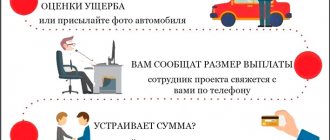What age car can be insured under CASCO?
Mostly CASCO is issued for new cars, which are characterized by expensive repairs. Vehicles without mileage are less susceptible to rapid wear and tear and have durable mechanisms. These factors are considered a kind of guarantee of the feasibility of the transaction for insurance companies, and also allow motorists to receive the necessary protection against risks.
In cases with old cars, the situation is a little more complicated. Typically, insurers are ready to provide protection for cars whose age ranges from 7-10 years. It is worth knowing that the lower limit (7 years) is provided for domestically produced vehicles. According to many, the Russian auto industry is not reliable. Insurance companies appear to share this view and are reluctant to expose their businesses to risk.
The age of the car to be insured can be up to 10 years, if the car is foreign-made. Vehicles from 7 to 10 years are insured on standard terms with the possibility of choosing any of the insurance programs provided by the company. The package may also include a compensation option that does not take into account the normal wear and tear of the vehicle.
In recent years, some insurers have made concessions to vehicle owners and raised the age limit for insured cars to 12 years. However, this condition implies a number of restrictions when concluding a transaction. Compensation payments can only be provided based on normal wear and tear. There are a number of other restrictions that you should ask your insurance company representative about.
There are rarely offers on the market that allow you to insure older cars. However, it is rare to find insurers willing to take such a risk. It is possible to insure a car older than 12 years under an individual insurance contract, which usually does not cost motorists a good price.
It is important to be prepared to provide the insurer with the result of the vehicle assessment. This information will allow the insurance company to assess the possible risks of concluding a transaction.
Interests of insurers
To begin with, let's look at it not from a consumer perspective, but from the point of view of the commercial interests of insurers. It is no secret that many of them refuse to service cars over a certain age, considering the margin from such transactions to be insignificant and the risks to be increased.
The criteria for the concept of “old car” in relation to CASCO insurance are established by the insurers themselves. On average, domestically produced technical equipment that is seven to eight years old and foreign cars produced 10 years ago or earlier are considered such (in Europe, an “old car” is a car older than 2-3 years). Many insurance companies set a so-called “insurance poverty threshold”, after which the issuance of a policy will be refused.
The skepticism of insurance companies regarding used cars is understandable: they break down more often, are more likely to become involved in accidents (including due to the technical condition of the car), and they usually have technologically outdated alarm systems installed, which increases the risk of theft, especially for especially for older cars, original auto parts are expensive.
As already noted, many insurance companies follow the simplest path - they simply refuse to issue CASCO insurance for old vehicles, thereby involuntarily exposing a promising niche in a huge segment of the auto insurance market. After all, according to statistics, a significant number of citizens buy used cars - 63% of total car sales of passenger cars.
As they say, a holy place is never empty. The lack of competition in issuing CASCO insurance to owners of used cars gives enterprising insurers the opportunity to extract significant margins, despite all of the above unfavorable business factors. At the same time, schemes are literally invented “on the knees” to minimize risks.
Is it profitable to insure an old car?
The decision regarding the advisability of insuring an old car is made by each car owner individually. It is impossible to give a universal answer to this question. However, the benefit of the transaction can be assessed by analyzing related factors.
Amount of insurance coverage
Old cars usually do not have a high price (unless the cars are rare, which are insured under special conditions). The low market value means that the driver will not have to pay a large amount for voluntary insurance.
Typically, inexpensive policies have a small amount of compensation payments. It is possible that the funds received may not be enough to cover repair costs.
Terms of the transaction
Insurance companies are reluctant to provide coverage for older cars. To neutralize possible risks, the insurer puts forward more stringent conditions for the provision of services. It is important to carefully read the terms of the contract and evaluate the feasibility of the transaction.
Availability of a franchise
A deductible presupposes the presence of a certain amount that is not payable in the event of an insured event. This feature allows you to significantly reduce the cost of the purchased policy. However, drivers must assess whether they are ready to cover part of the damage themselves in the event of an accident.
What to do if your car insurance claim is denied
The refusal of one insurance company is not a reason to stop trying to purchase a policy. Each insurance company has its own terms of service and its own restrictions. Therefore, if the answer is negative in one company, you should contact the offices of other companies and find conditions that suit both parties.
Since CASCO is not compulsory insurance, litigation can turn against the car owner. The company may increase the tariff for services and limit other conditions, making the purchase of the policy unprofitable.
CASCO cost for an old car
It is a mistake to believe that an insurance policy for an old car is always more expensive than for a new one. This misconception only reflects one side of things: used cars do have a higher rate. However, the total cost is determined not only by the tariff, but also by the total sum insured.
To clearly reflect the real situation, it is worth looking at two examples:
- A car owner wants to insure a vehicle manufactured in 2014, costing 900 thousand rubles. The tariff is 6%. Thus, the driver will have to pay 54 thousand rubles for insurance.
- The owner owns a car with a market value of about 200 thousand rubles. The tariff in this situation will be 12%. The motorist will pay 24 thousand rubles for a CASCO policy.
A favorable tariff rate is not the only way to reduce the cost of a policy.
Other factors influencing the cost include:
- aggregate sum insured;
- break-even;
- coefficient of age and experience of motorists;
- the presence or absence of anti-theft systems;
- the use of special insurance programs (for example, insurance before the first risk occurs, 50/50 and others).
You can get acquainted with the final amount of CASCO insurance using a special calculator. The possibility of calculation is provided on all websites of licensed insurance companies.
Games with tariffs
First of all, for used cars the cost of the CASCO contract and the amount of insurance increases. Thus, for a new car the insurance rate is set at around 5-8% of the market value of the vehicle; for old cars it can reach 20%. In addition, coefficients are introduced based on the service life of the car. For example, the first year – minus 15%, and then 10% annually.
The presence of a franchise clause in the contract should be taken for granted. That is, the insurance company assigns part of the payments for an insured event to the car owner himself. For example, if the damage caused to a car during an accident amounted to 50 thousand rubles, and the deductible in the contract is set at 20 thousand, then the insurance company will compensate only 30 thousand rubles. Although among the insurers' proposals for used cars, one can also find benefits from a franchise: its presence is accompanied by a reduction in the cost of insurance. For insurers, the deductible is beneficial from the point of view that if it is included in the contract, the client will not turn to them for compensation for losses in the event of minor damage to the car (scratches, broken sidelights, etc.), that is, when the cost of compensation is lower than the amount of the deductible . And according to statistics, such incidents with minimal damage account for up to 80% of all insured events.
Watch a video on car insurance over 5 years old
Insurance companies also manipulate the degree of wear and tear of the car. The calculation is based on the fact that most motorists prefer to overpay and purchase CASCO insurance without taking into account the wear and tear of the car. At the same time, the policy costs about 15-20% more, but there is no need for an independent appraisal examination. In addition, restoring a used car after an accident will cost almost the same as a new one (more on this below) . But the policy, taking into account wear and tear, guarantees payment of the entire amount in the event of theft or complete destruction of the car.
It is possible to understand insurers, especially taking into account the fact that in recent years a category of unscrupulous clients has appeared, who can be called “professional insurers” (by analogy with the so-called “professional tourists”) who manage to make money through the official insurance business.
How to make your policy cheaper
In order to attract the target audience of the product, insurers offer a variety of insurance packages. This approach provides motorists with the opportunity to choose the most suitable program, and insurance companies with sustainable income. To get the most profitable product, the driver must take into account individual preferences and become familiar with the features of insurance products. You can save money using common service packages.
Partial CASCO insurance
Unlike a full package of insurance services, partial insurance provides protection only against certain risks. The owner of the vehicle independently determines which insurance events will be indicated in the policy. The most common partial insurance package includes protection against car theft and theft.
When choosing partial insurance, the service user pays the full insurance premium only for the selected risks. Other insurance events are subject to a deductible, which ranges from 70 to 90% of the cost of the vehicle. Thus, the cost of voluntary insurance is reduced by half.
System 50x50
The use of this system assumes that the motorist pays only 50% of the cost of insurance. However, if an insured event occurs, the owner of the vehicle will receive only half of the total amount of losses.
This means that after an accident there are two possible scenarios:
- the driver receives compensation, adds personal funds to the amount received and repairs the car;
- the car owner receives support from the insurance company, does not contribute his own funds and receives only half of the necessary repairs.
CASCO with reimbursement only for the cost of spare parts
A fairly popular insurance product that is actively used by owners of used cars. Under the terms of this agreement, the insurance company undertakes to pay for the purchase of original spare parts for the vehicle. The insurer is not responsible for carrying out repair work. The motorist receives a benefit of up to 45% percent.
Application of coefficients
For drivers with a positive driving history and extensive experience, preferential terms of voluntary insurance are provided. Also important indicators for reducing the cost of protecting movable property from risks are the age of the motorist and the features of his cooperation with the insurance company.
CASCO limited mileage
This program is designed for motorists who do not actively use their car. This feature suggests that the risk of certain insurance events (for example, in an accident) for such drivers is much lower.
The car must have a mileage ranging from 5 to 20 thousand kilometers per year. If the motorist exceeds the permissible limit, he will have to pay the previously saved amount towards insurance.
Aggregate sum insured
The “Aggregate Sum Insured” insurance package implies that compensation payments under CASCO cannot exceed the average market value of the vehicle. In this case, the insurance amounts add up. That is, when providing compensation for each insured event, the amount of the previous compensation is deducted from the payments.
You can understand the features of this insurance package using a specific example. You need to imagine that the owner of a car insured under CASCO was involved in a traffic accident, as a result of which he received damage in the amount of 50 thousand rubles. Then the policyholder’s vehicle, with a market value of 300 thousand rubles, was stolen by criminals. Under insurance, the motorist will receive the amount minus the previously provided funds, that is, 250 thousand rubles.
Benefits for new clients
Insurance companies attract new customers with various discounts. Market representatives are ready to reduce the cost of the policy by 5-35%. You can also get a discount for purchasing a policy online.
Other offers
Often, insurers provide a discount if the driver wishes to purchase several insurance products at once. The benefit of such a solution is on average about 15%. Since there is quite fierce competition in the insurance market, companies are constantly developing new attractive offers. It is important to check their availability with the organization’s employees.
Repair after an insured event of old and new vehicles
The cost of repair work will consist of the following items:
- Prices for spare parts requiring replacement.
- Cost of additional materials (paint, primer).
- Payment for the work of specialists.
The maximum cost of repairs cannot exceed the limit of the sum insured under the contract. That is, for a car costing 150,000 thousand, repairs cannot cost 200,000 rubles.
For this reason, payments based on used car repairs may often not be enough for a complete restoration. The owner will have to compensate for the difference at his own expense. This situation is extremely rare with new cars.
Lack of compensation most often occurs in the following situations:
- There is a deductible in the contract, and the amount of damage does not exceed its value. Thus, the repair of mirrors or glass will not be paid if the deductible is 5-6%;
- When calculating the amount of damage, wear and tear of the car is taken into account. This parameter can be determined either monthly or daily. Details must be specified in the contract. A more profitable option is daily payment.
Another significant difference in repairing old and new cars is the choice of organization to carry out this action. Depending on age, this could be:
- Dealership center – for vehicles under warranty.
- A service station that is a partner of the insurer - for all other cars.
Which insurance companies and under what conditions can you get insurance?
Most representatives of the insurance market refuse to cooperate with car owners whose vehicles are older than 10 years. But despite this, some insurance companies are ready to protect this category of motorists from risks.
| Insurance Company | Insurance programs | Features of insurance |
| Renaissance insurance | CASCO with Safedrive telematics | • protection against theft of the vehicle, damage to it and in case of total loss • transportation of the car from the scene of the accident • deductible in the amount of 20 thousand rubles • free travel of the emergency commissioner to the scene of the accident • provision of repairs in the technical center • one-time glass restoration without certificates |
| Rosgosstrakh | Anti-crisis CASCO | • provision of repairs at the direction of the insurer • protection against theft, total loss and damage in an accident • free expansion of insurance coverage when leaving the country • provision of only one compensation after an accident within the established maximum amount |
| Absolute insurance | Programs “Standard” “Comfort” and “Prestige” | • Free transportation of the car from the scene of an accident • availability of a franchise (15 thousand rubles) |
| ERGO | Standard | • protection against theft and total destruction of the vehicle • restoration of glass coverings (repeatedly) • dispatcher support at any time of the day • if necessary, payment of up to 3-5% of the insured amount - provision of funds without papers • deductible in the amount of 20 thousand rubles • unlimited number of requests , but with the provision of no more than 6 thousand rubles for each case |
Thus, owners of older cars still have a choice. It is important to evaluate the personal benefits of cooperation with each company and make an informed decision.
How to apply for CASCO insurance for a car older than 10 years
Registration of a policy for a vehicle older than 10 years involves the following algorithm of actions:
- Selecting an insurance company that will provide acceptable insurance conditions (they may differ in each company).
- Preparation of the required package of documents (applicant’s passport, driver’s licenses of all vehicles authorized to drive, vehicle title, contract for the installation of an anti-theft system, etc.).
- Drawing up a vehicle inspection report together with the insurer.
- Drawing up an insurance contract listing the necessary information (year of manufacture of the model, data of the policyholder, list of persons allowed to drive the vehicle, envisaged risks, duration of insurance, etc.). The content of the agreement differs in each specific case; there is no standard form provided for CASCO.
- Signing of documents.
- Payment of insurance premium.
- Receiving documents: a copy of the contract, CASCO policy, inspection report, receipt confirming payment, insurance rules.
Purchasing a policy online for old cars is problematic, since a mandatory condition for concluding a contract is to inspect the vehicle and draw up a corresponding report. Therefore, it is possible to apply for the program during a personal visit to the IC office.
Pro & Contra
From a consumer point of view, issuing CASCO insurance for a used car is a desirable, but optional, action. However, there are two other, polar opinions on this matter.
Some believe that CASCO is a waste of money, and in some cases voluntary insurance may even be contraindicated. As an argument, the observation is given that the lack of compensation for car repairs in the event of an accident, theft or damage, say, from an icicle falling from the roof, disciplines the owner. They say that everything depends on oneself: attentiveness on the roads, installation of modern alarm systems, correct parking - any surprise should be anticipated and calculated. And then you won’t have to pay for repairs. What happened was fate.
This position is reminiscent of one funny dialogue overheard at a service station. A client is hovering around his car hanging on a lift. A mechanic is working under the car. Client: “My suspension is probably loose. At speed the car begins to swerve along the road. But, you know, it’s even more reliable: I’m always collected while driving, in suspense, always ready to react.” Car mechanic: “So let me cut your brake hoses for safety!”
Perfectionists are convinced that with a thoughtful approach to voluntary CASCO insurance, as well as having such a quality as stubbornness (in the good sense of the word), you can derive some benefits from this insurance, and especially if we are talking about a used car.
First of all, about calculating the cost of insurance. Indeed, for a used vehicle it can be several times higher than for a car from scratch. But this is calculated as a percentage of the cost of the car. In absolute numbers, everything may look slightly different.
Let's say a new car costs 1 million rubles. insured under CASCO. The tariff was 5%. Thus, 50 thousand rubles were paid for the policy. After ten years of accident-free driving, the UK agreed to once again insure this car, but, naturally, at a higher price - 15% of the market value of the car, which during this time has decreased by half and is already 500 thousand. That is, the policy in this case will cost one and a half times more, 75 thousand rubles. But in some cases, the actual costs of CASCO for a new and used car may be almost equal.
Here we should make a short digression to explain how the real value of a car is calculated depending on its age.
For this, there are so-called depreciation standards, according to which in the first year of operation the car loses 18% of the original price, 15% in the second and then 10-12% annually. But auto insurers usually calculate the real value of a car without bothering with calculations. Corresponding calculators are available on specialized websites, for example, auto.ru. The calculation is made based on data on the region of registration, make, model, year of manufacture and some other parameters. Then two options are selected - the most expensive and the cheapest. The average price between them will determine the actual cost of the car.
Saving on repairs
And yet, for the owner of a used car, the most win-win way to save money when purchasing a CASCO policy is the terms of the contract regarding car repairs after an insured event. This is where his main advantage over the owner of a new car lies.
The latter has no choice: during the warranty period, he is obliged to present his vehicle to the technical center of the official dealer of this brand, and after the warranty expires, to the insurer’s service station. In this case, high-quality repairs are guaranteed, but in terms of prices (cost of a standard hour), they will not be cheap. At the same time, one should not write off the “human factor” - in the sense that often the owner of a technical service and top managers of an insurance company have relationships that go beyond business. Such connections bordering on corruption are especially common in the regions.
Owners of used cars have a choice: compensation for damage is possible both at the insurer’s service station and at a service center of the policyholder’s choice. In addition, monetary payment for damage received is practiced, and then repairs can be made anywhere, even in the garage of some Vakhtang. On the one hand, such an agreement will cost more (about 20%). On the other hand, the option is appropriate, for example, in the above-mentioned case of purchasing a policy on the condition that the insurance company pays only for spare parts.
At the same time, it becomes possible to use analog spare parts, which are cheaper than original ones, because the insurance company makes calculations (if the car is insured without taking into account wear and tear) only according to price lists for original parts. But a reservation should be made: with regard to used cars, not every insurance company will agree to draw up a CASCO agreement without taking into account the wear and tear of spare parts, as well as without a franchise condition.
Wear of parts can be calculated either monthly or daily. The calculations are based on the technical expertise carried out during the process of issuing a CASCO policy. For owners of cars with high mileage, it is more profitable to insist on a daily calculation of wear and tear, since over a month of operating the car, the actual cost of parts decreases, although not critically, but still noticeably.
From the practice of insuring used cars, it is clear that the insured amount does not always cover the cost of repairs. Many factors have an impact: the low market price of such cars, the franchise, the dynamics of wear and tear of parts, the client’s desire to save money in all the listed and unmentioned ways.
And yet, in the end, the owner who insured his used car under CASCO remains at a loss - without the policy, the repairs would have to be paid in full. In the event of an insured event, of course.










